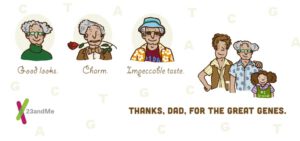Around this time every year, we turn our attention toward the patriarchs of our respective families and collectively ask: “What should we get dad for father’s day?”

Today, we want to step back and ask just the opposite:
“Genetically, what do we get from dad?”
Our customer care team has received countless phone calls from women wondering if they inherited any DNA from their fathers. The questions pop up because women don’t inherit a Y-chromosome from their fathers, and thus do not receive a paternal haplogroup assignment.
But if you were planning to call about this, we have good news for you — you actually inherit half of your DNA from your father.
The DNA 23andMe uses for most of our features, including Ancestry Composition and DNA Relatives, is inherited from both of your parents as a mixture and reflects both of your parent’s ancestry. 23andMe looks not just at the sex chromosomes – the X and the Y – but the other 22 pairs of chromosomes, called the autosomes. You can read more about how DNA is transmitted through the generations in our Genetics 101 series.
That being said, the Y-chromosome is only inherited by males. That allows 23andMe to make a paternal haplogroup assignment for male customers. Paternal haplogroups are families of Y chromosome types that all trace back to a single mutation at a specific place and time, and can help customers wanting to learn more about their ancestral origins. Some of us like to think that the Y-chromosome is responsible for a father’s ability to look like he appreciates ugly ties, but scientists don’t see it that way.
Geneticists, historians, and genealogists have actually discovered remarkable information using Y-chromosome DNA. So, for example, my paternal haplogroup is R1a1a. This branched off about 12,000 years ago and among people, with Western European ancestry, it occurs in about one-third of Norwegian men and a quarter of men from the far northern British Isles. Knowing that does give me a better understanding of my own ancestry.
Let me explain why this is.
First, you need to understand how the Y-chromosome is passed down. As we mentioned above, almost all of your DNA is inherited as a mixture, however, the Y-chromosome is handed down directly from a father to his son. For this reason, there is no mixing, or as geneticists say — there is no recombination — when it comes to the Y-chromosome. This is important to note when learning about your ancestry through your Y-chromosome because it only reflects one branch of your ancestry – your father’s, father’s, father’s, father… you get the idea.
You can technically trace your Y chromosome all the way back to the earliest known human civilizations.
If we’ve emailed in the past this might sound familiar, but we should confess something to the rest of you before we go any further, Y-chromosome DNA does not provide a comprehensive view of your ancestry. Features that use DNA that you inherit from both of your parents can identify relationships or ancestry from any branch of your family tree.
Okay, back to Y-chromosomes. Soon after geneticists discovered how a Y-chromosome was inherited, word got around to the historians. Historians took note that at certain points in ancient history Y chromosomes changed at specific places. Soon, they started naming and ordering these changes using this information to 
At this point, you are probably thinking that you haven’t heard a lecture this longwinded since your dad sat you down as a kid. But, before we wrap this up we want to explain why you should be interested in your father’s Y haplogroup. These days there are several hundred known paternal haplogroups if you are genotyped by the service we assign to you a paternal haplogroup. You can treat this knowledge as a sort of genetic family crest passed down from an ancient time from each father to his sons. Women can infer their paternal haplogroup by having a male relative on your father’s paternal line. So that could be your father, brother, or paternal uncle or paternal male cousin.
You can read more on our blog about how paternal haplogroups can provide insight into more recent history. If you want more information about paternal haplogroups in general, visit our help center. And because we have undoubtedly forgotten to send a card: happy father’s day dad, thanks for our Y chromosomes.